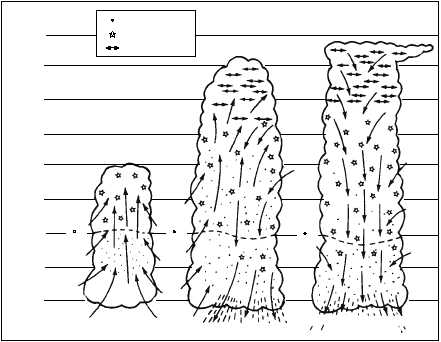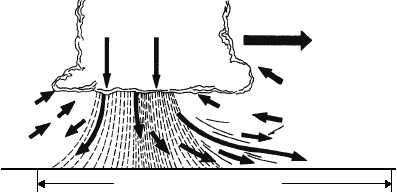consists of three distinct stages; they are the cumulus.
stage, the mature stage, and the dissipating or anvil
stage. (See fig. 5-15.)
CUMULUS STAGE.—Although most cumulus
clouds do not become thunderstorms, the initial stage of
a thunderstorm is always a cumulus cloud. The chief
distinguishing feature of this cumulus or building stage
is an updraft, which prevails throughout the entire cell.
Such updrafts vary from a few feet per second in the
early cells to as much as 100 feet per second in mature
cells.
MATURE STAGE.—The beginning of surface
rain, with adjacent updrafts and downdrafts, initiates
the mature stage. By this time the top of the average cell
has attained a height of 25,000 feet or more. As the
raindrops begin to fall, the frictional drag between the
raindrops and the surrounding air causes the air to begin
a downward motion. Since the lapse rate within a
thunderstorm cell is greater than the moist adiabatic
rate, the descending saturated air soon reaches a level
where it is colder than its environment; consequently,
its rate of downward motion is accelerated, resulting in
a downdraft. (See fig. 5-16.)
5-19
AG5f0515
40,000
35,000
30,000
25,000
20,000
15,000
10,000
5,000
FREEZING
LEVEL
45,000
RAIN
SNOW
ICE CRYSTAL
CUMULUS
STAGE
MATURE
STAGE
ANVIL OR
DISSIPATING STAGE
FIRST RAIN AT SURFACE
RAIN DECREASING
AT SURFACE
0 C
0 C
0 C
Figure 5-15.—Life cycle of a thunderstorm cell.
AG5f0516
WIDTH UP TO ABOUT SIX MILES
COLD AIR SINKING
DIRECTION
OF STORM
OUTWARD FLOW OF
COLD AIR THAT
PRECEDES THE RAIN
5000 FT.
SURFACE
Figure 5-16.—Downdraft beneath a thunderstorm cell in the mature stage. Arrows represent wind flow. Dashed lines indicate
rainfall.



